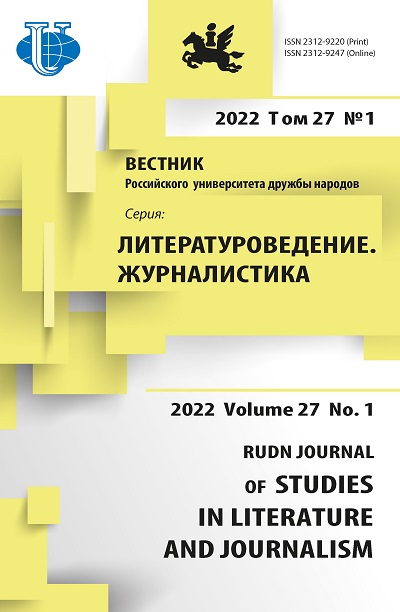Guy Fawkes and the Antinomies of the Digital Age
- Authors: Pronina E.E.1
-
Affiliations:
- Lomonosov Moscow State University
- Issue: Vol 27, No 1 (2022)
- Pages: 137-146
- Section: JOURNALISM
- URL: https://journals.rudn.ru/literary-criticism/article/view/30728
- DOI: https://doi.org/10.22363/2312-9220-2022-27-1-137-146
Cite item
Full Text
Abstract
The article examines the phenomenon of the transformation of the image of Guy Fawkes into a meme - a universally significant symbol. The history of the formation of the symbol, which combined the events of the Gunpowder Conspiracy of the early XVII century and the social movements of the early XXI century, is considered as a kind of natural longitudinal experiment that sheds light on the process of personality evolution and the key problems of the digital era. The hypothesis put forward deals with the initially ambivalent nature of “Guy Fawkes Night” celebration viewed as a symbolic realization of intentions tabooed by the social hierarchy. The article analyzes allusions to the topic of the Gunpowder Conspiracy in popular culture, the peculiarities of using the name and mask of Guy Fawkes as elements of self-identification. The author concludes that the symbolic identification with Guy Fawkes indicates the increasing need of society for independence and self-organization and a sharp aggravation of the antinomic relations between official and unofficial culture, first described by M. Bakhtin on the example of a medieval carnival. The role played by the ancient Celtic mysteries, as well as modern digital technologies, in the evolution of the symbol is also outlined. The article discusses how archaic rituals contributed to the rethinking process of the image of Guy Fawkes in the context of binary oppositions of the collective psyche. The specifics of the development of the “Guy Fawkes phenomenon” in digital society are considered as a predictor of the next stage in the evolution of society and personality.
Keywords
About the authors
Elena E. Pronina
Lomonosov Moscow State University
Author for correspondence.
Email: pronina.elena@gmail.com
ORCID iD: 0000-0001-8715-830X
Doctor of Philology, Doctor of Psychology Professor at the Chair of Department of Periodical Press, Faculty of Journalism
9 Mokhovaya St, Moscow, Russian Federation, 125009References
- Assange, J. (2012). The Unauthorised Autobiography. Мoscow: Alpina Publisher Publ. (In Russ.)
- Bahtin, M.M. (2015). The work of Francois Rabelais and the folk culture of the Middle Ages and the Renaissance. Moscow: EKSMO Publ. (In Russ.)
- Cain, А. (2016). We asked 3 etiquette experts whether it's OK to call people ‘guys’ — and learned all about the word’s weird history. Businessinsider. Nov. 5, 2016. Retrieved from https://www.businessinsider.com/the-weird-history-of-the-word-guys-2016-11
- Doyle, K.A. (1966). The Musgrave Ritua. In Doyle, K.A. The complete collection of works in 8 vol. (Vol. 2, pp. 90–110). Moscow: Pravda Publ. (In Russ.)
- Frazer, G.G. (2006). The golden Bough. Moscow: EKSMO Publ. (In Russ.)
- Lévi-Strauss, C. (2011). Structural anthropology. Мoscow: Neoklassik, Astrel’, AST.
- Levi-Strauss, C. (2011). Structural anthropology. Мoscow: Neoklassik, Astrel’, AST.
- Moore, A., & Lloyd, D. (1990). V For Vendetta. New York: DC Comics, Inc.
- Porter, R. (Ed.) (1993). Myths of the English. Cambridge: Polity Press.
- Pronin, E., & Pronina, E. (1999). Communication openness and information security: borders and guarantees. In Media, communication and the open society (pp. 243–247). Мoscow: IKAR Publ. (In Russ.)
- Pronin, E.I., & Pronina, E.E. (2013). Media psychology: The latest information technologies and the human phenomenon. Social Sciences and Contemporary World, (2), 151– 161. (In Russ.)
- Pronina, E.E. (2002). Psychology of Journalism. Мoscow: MSU Publ. (In Russ.)
- Reich, J.E. (November 5, 2015). David Lloyd on ‘V for Vendetta’ and The Guy Fawkes Mask’s Legacy. Techtimes. Retrieved from https://www.techtimes.com/articles/ 103476/20151105/guy-fawkes-day-v-for-vendetta-legacy.htm
- Rybakov, B.A. (1988). Paganism of Ancient Russia. Мoscow: Nauka. Publ. (In Russ.) Rybakov, B.A. (1981). Paganism of the ancient Slavs. Мoscow: Nauka Publ. (In Russ.)
- Sharpe, J. (2006). Remember, Remember the Fifth of November: Guy Fawkes and the Gunpowder Plot. Croydon: Profile Books; New Edition.
- Tylor, E.B. (1989). Primitive culture. Мoscow: Politizdat Publ. (In Russ.)
















